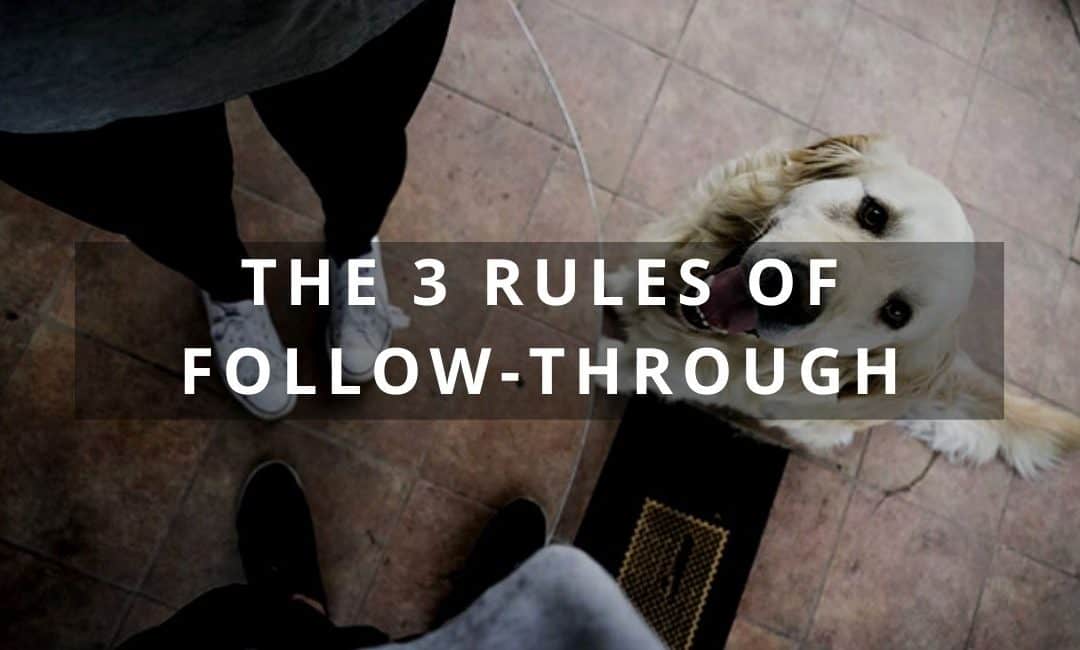Every time you give your dog a command, you’re communicating more than just words. Yes, you’re giving direction, but you’re also teaching your dog about your expectations. When dogs respond inconsistently to commands, it’s almost always because we have taught them to do just that.Â
Think about it. Do you ask your dog to sit, down, stay, or come, but only follow through if you’re not too busy or distracted?
Do you ask your dog to do one thing, but settle for another as “good enough”?
Do you switch back and forth between commands, trying to find one your dog will actually listen to?
We all do these things at one time or another, but if it becomes a habit — then we are teaching our dogs that what we say has no meaning.
(Keep in mind, we can’t explain later that “I really didn’t mean that”! ;-))
With dogs, how we follow through with our actions means everything.
Seem kind of intimidating? I hear you! But honestly, it doesn’t have to be.
In fact, there are 3 very simple rules to follow that will help improve your dog’s obedience dramatically.
Know your attention limitations
Training requires not just your dog’s attention, but yours as well. And let’s face it, there simply will be times when it’s not practical to take your attention away from what you’re doing, so that you can give it to your dog.
Maybe you’re on the phone with your boss, signing for a package at the door, or driving in heavy traffic. Some situations simply don’t allow for us to excuse ourselves to pay attention to the dog.
If you know you won’t be able to follow through with the command you give your dog, don’t give a command in the first place.
It is better to say nothing than to teach your dog that your words mean nothing. Yes, it’s that important!
Giving direction, and then not following through to be sure your direction is complied with, tells your dog that your words have no consistent meaning. This will actually set you back in your dog training.
Don’t waffle
There are times when all of us give a particular command, when in reality, we’d be perfectly happy if our dogs did a range of things.
Maybe you’ve said come, when you really just wanted your dog to stop pestering the cat. Maybe you’ve said sit, when you really just wanted your dog to stop fidgeting and settle down.
The problem is, it doesn’t matter what you would settle for – your dog needs to know that your directions are “trustworthy”.
Once the command has been spoken, follow through with the exact command you gave, even if you don’t really need for your dog to do that anymore.
Pick a command and stick to it
Again, this is about expectations. Let’s say Serena wants to pet Sparky, but doesn’t want him jumping all over her when she does it.
She starts off well, asking Sparky to sit as he approaches. Sparky starts to sit, but then gets distracted and wanders past her.
Instead of persisting with the command she gave (sit), Serena allows Sparky to lead the game here.
“Come!” calls Serena, as Sparky moves past her. Sparky turns around to come, but on his way back, notices the new houseplant and goes to check it out.
“Leave it!”, yells Serena.
Suddenly Sparky remembers Serena is in the room, and comes bouncing over. Serena is relieved (and a little amused) and manages a stern “Sit!!”.
Sparky stops, grins, and flops down on the floor for a belly rub. A relieved Serena praises “Good Boy!”.
Pretty funny, isn’t it? Maybe familiar, too? And while we can without a doubt sympathize with Serena’s frustration, hopefully we can also see her mistake. Yep – no follow-through!
Moving from command to command, hoping that eventually one will “work”, actually teaches your dog to ignore you.
After all, if we don’t follow through on the first command, why in the world would our dog think that the next one, or one after that, should be any different?
Choose a command – something you know your dog is capable of doing – then calmly and pleasantly persist until you get the response you asked for.
What about you? Do you feel your dog’s response to commands could be more consistent? Start out by working on improving your follow-through. I guarantee your dog will thank you for it!
I hope you enjoyed and found value in this article. If you did, please share with your friends!
Best,
julie
(bio)
